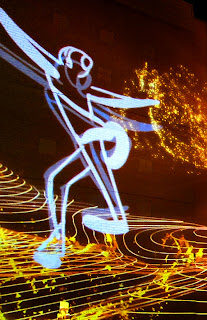 |
| Pedestrian walkway is original, the second railing is a modification. |
It's time to put the Blackfriars Bridge out of its misery — and make no mistake about it, the beautiful, heritage structure is suffering. The passing years, 137 to be exact, have taken their toll.
Decorative caps are missing from fasteners on the walkway barrier, original iron bracing is bent and distorted, the structure has been modified for pedestrian safety and overall bridge integrity.
 |
| Some decorative caps covering fasteners are missing. |
Bowstrings are among the rarest types of truss bridges today but they enjoyed a brief period of popularity from about 1855 into the 1880s.
During that period, thousands of wrought iron bowstring truss bridges were produced by numerous American bridge builders but two Ohio-based manufacturers stand out: WIBC of Canton and King Iron Bridge, King Manufacturing Company, Cleveland. The bowstring was the most commonly erected all-metal bridge of the 1870s and both Ohio companies sold their own patented bowstring designs.
In 1875 not one but two WIBC designed and fabricated bridges were erected over the Thames River in London, Ontario: The Blackfriars Bridge and a sister bridge, the Victoria, at the southern end of Ridout Street. The Victoria was replaced in 1926.
 |
| Replacement support for upper handrail is a serious mismatch. |
Using some 9000 lbs. of wrought iron and cast iron, a bridge like the Blackfriars gives a whole new meaning to the warning "some assembly required." Often the factory sent along an engineer to assist with construction.
Contrary to local folklore, the London bridge is not the only wrought iron bowstring truss bridge still carrying vehicular traffic in North America. There are at least six others but not one carries the amount of daily traffic endured by the hard-working London span.
I believe asking a century old, and then some, bridge to carry 4000 vehicles a day 365 days a year is foolish. Think of the damage that winter road-salt alone inflicts on this treasure. And make no mistake, the London bridge is a treasure. The Boner Road Bridge in Indiana, built in 1869, has been completely restored. Yet, it is only asked to carry limited traffic.
 |
| Boner Bridge, a three span bowstring truss, has been completely restored. |
And the Boner Bridge is not the only bowstring that has been lovingly restored. There are others but with one big difference: Most were restored and then retired to a future of pedestrian traffic only. I know of 20 bowstring truss bridges that have been re-purposed for pedestrian/cyclist use only.
 |
| Restored Rodrick Bridger relocated to university campus. |
One of my favourite stories is the one surrounding the Old Richardsville Road Bridge in Kentucky. The old road, and thus the bridge, receives only limited use. Why: There is a new Richardsville Road.
 |
| Old Richardsville Rd. Bridge still carries vehicular traffic. |
The Blackfriars Bridge, with its 225-foot clear span, eliminated the intermediate supports required by the previous wooden bridges. In theory, the river-spanning length minimized the risk of a wash out caused by spring floods. It was a good theory; The Blackfriars Bridge is entering its 139th year of service.
It's time to find our beautiful, heritage bridge a new home. At the very least, let's move it a few feet up or down river — which ever makes the most sense. Let's restore our wrought iron work of art and craft. Let's give our now-rare-beauty another century or more of life.
Remember the five Rs:
- Remove it
- Restore it
- Relocate it
- Re-purpose it
- Reuse it
 |
| Remove it, restore it and reserve it for walkers and cyclists only. |
Below
The first three pictures (below) show the wooden bridges that once served the area. Note the mid river supports required by all the wooden structures.The last picture is an early image of the Blackfriars Bridge still in use today.
 |
| Note the in-river supports required by the wooden bridges at this location. |
 |
| Ivey Family London Room, London Public Library, London, Ontario, Canada |









































